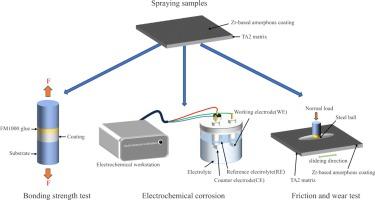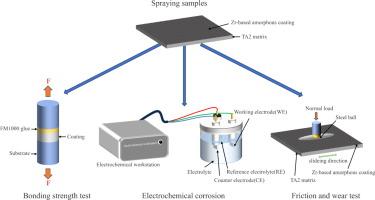TA2表面zr基非晶复合涂层的制备及其耐极端腐蚀磨损性能
IF 6.9
2区 材料科学
Q2 CHEMISTRY, PHYSICAL
引用次数: 0
摘要
采用等离子喷涂技术在TA2基体上制备了zr基非晶涂层。通过结合涂层拉伸测试、电化学腐蚀、摩擦磨损测试、分子动力学(MD)和密度泛函理论(DFT)计算,分析了腐蚀和耐磨涂层的界面结合强度、摩擦学性能和耐蚀性。结果表明:zr涂层组织均匀致密,无裂纹、气孔等缺陷,涂层厚度约为227.07 μm;zr涂层在TA2基体上的结合强度达到17.2 MPa,硬度为550 Hv。zr涂层在20 % HNO3溶液中的腐蚀速率为0.0093 mm/a。对TA2衬底的保护效率为94.35 %。Zr41.2Ti13.8Cu12.5Ni10Be22.5(100)晶体表面的功函数值最大为3.467 eV, zr涂层越难使电子逸出,耐蚀性比TA2更好。氧原子在ZrO2钝化膜中的扩散系数(6 × 10−8)大于TiO2钝化膜中的扩散系数(1.6667 × 10−9)。与TA2相比,zr涂层的磨损率(3.19 ×× 10−7mm3N−1mm−1)较低,主要以疲劳磨损和氧化磨损为主。本研究为深入分析zr基非晶态涂层在稀硝酸溶液中的腐蚀磨损机理提供了理论基础,并为新型防腐耐磨涂层的设计提供了有意义的指导。本文章由计算机程序翻译,如有差异,请以英文原文为准。


Preparation of Zr-based amorphous composite coatings on TA2 surface and their resistance to extreme corrosion and wear
In this paper, Zr-based amorphous coatings (Zr-coating) were prepared on TA2 substrate by plasma spraying technique. By employing a combination of coating tensile testing, electrochemical corrosion, friction and wear tests, molecular dynamics (MD), and density functional theory (DFT) calculations, the interfacial bonding strength, tribological properties, and corrosion resistance of the corrosion- and wear-resistant coatings were analyzed. The results show that: The organization of Zr-coating is uniform and dense without cracks, pores and other defects, and the thickness is about 227.07 μm. The bond strength of Zr-coating on TA2 substrate reaches 17.2 MPa, and the hardness is 550 Hv. The corrosion rate of Zr-coating in 20 % HNO3 solution is 0.0093 mm/a. The protection efficiency for TA2 substrate is 94.35 %. Zr41.2Ti13.8Cu12.5Ni10Be22.5(100)crystal surface of the value of the function of the work of the maximum 3.467 eV, Zr-coating the more difficult for electrons to escape, corrosion resistance is better compared to TA2. The diffusion coefficient of oxygen atoms in the ZrO2 passivation film (6 × 10−8) was larger than that in the TiO2 passivation film (1.6667 × 10−9). In addition, Zr-coating has a lower wear rate (3.19 10−7mm3N−1mm−1) compared to TA2, which is mainly dominated by fatigue wear and oxidative wear. This study provides a theoretical basis for an in-depth analysis of the corrosion and wear mechanisms of Zr-based amorphous coatings in dilute nitric acid solutions, and provides meaningful guidance for the design of new corrosion and wear-resistant coatings for use.
求助全文
通过发布文献求助,成功后即可免费获取论文全文。
去求助
来源期刊

Applied Surface Science
工程技术-材料科学:膜
CiteScore
12.50
自引率
7.50%
发文量
3393
审稿时长
67 days
期刊介绍:
Applied Surface Science covers topics contributing to a better understanding of surfaces, interfaces, nanostructures and their applications. The journal is concerned with scientific research on the atomic and molecular level of material properties determined with specific surface analytical techniques and/or computational methods, as well as the processing of such structures.
 求助内容:
求助内容: 应助结果提醒方式:
应助结果提醒方式:


